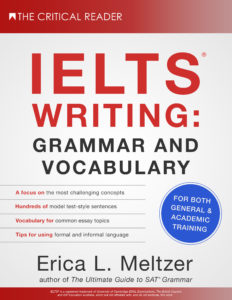Although it is very important to make a good first impression on your examiner by writing a strong introduction to your Task 2 essay, the body paragraphs are where your overall mark will really be determined.
Body paragraphs form the substance of your essay, and so it is important that they be structured logically (Coherence and Cohesion), and in a way that allows you to respond to the question as directly and thoroughly as possible (Task Response).
Because the Writing test requires you to apply so many skills at the same time, it can be very helpful to have a standard body-paragraph “formula” that can be used for virtually any question.
Once you have determined the focus of your paragraph, each new idea can be introduced with linking device + point.
You can then discuss that point or give an example to illustrate it using no more than two additional sentences. The limit prevents repetition, over-explaining, and going off-topic.
Like this:
Point 1
Firstly/To begin/A major (dis)advantage + first reason: 1 sentence
Example or explanation: 1-2 sentences
Point 2
Furthermore/In addition/Secondly, + second reason: 1 sentence
Example or explanation: 1-2 sentences
Point 3 (optional, depending on length and structure)
Finally/Lastly + third reason: 1 sentence
Example or explanation: 1-2 sentences
Now, are you going to impress anyone with the originality of your structure? Absolutely not. But guess what: that doesn’t matter. Clear writing is generally pretty formulaic—that’s a big part of what makes it effective. Its straightforwardness and predictability allow the reader to focus on the writer’s ideas, rather than trying to figure out what they’re literally trying to argue. And if you’ve been stuck in Band 6 and are trying to get to Band 7, originality in terms of structure should be the least of your concerns.
You should also focus on using common, straightforward linking devices (like the ones above) correctly so that a reader can easily follow your argument. Do not try to be fancy or original. High-scoring essays use cohesion in a way that does not draw attention to it. (And if you don’t trust me, check the Band Descriptors; it’s right there under Band 9.)
The number of sentences you write for each point will depend on how much information you need to include in the essay as a whole. For example, if you are required to discuss both advantages and disadvantages, you will need to have two substantial body paragraphs, each with multiple points. As a result, you will be able to cover each individual reason in less detail. (Note that if you are asked for reasons or (dis)advantages, plural, you must discuss more than one in order to score well.)
If, on the other hand, your essay is primarily devoted to expressing a single viewpoint, then you will be able to write more for each idea. For the purposes of illustration, I’ve deliberately made the full example below a bit long.
In addition, you should always spend a few minutes brainstorming and outlining so that your points are as strong and distinct from one another as possible. Otherwise, your writing risks becoming vague, repetitive, and overly general.
Let’s look at a sample body paragraph based on the following question:
The most important consideration when choosing any career or job is having a high income. To what extent do you agree with this statement?
Writer’s opinion: Mostly disagree. While income is a significant consideration for workers, a range of lifestyle factors should also be taken into account.
Sample Body Paragraph Outline
Point 1: Personal fulfillment and competence
Point 2: Work/life balance
Point 3: More money does not equal more happiness
Please note: Common collocations appropriate for Task 2 are underlined. This is the type of formal idiomatic language that, when used along with appropriate grammar and vocabulary, can help you achieve a high band score.
Point 1
First(ly), when deciding what type of career to pursue, people must consider what type of work they enjoy and are most suited to.
Discussion
(1) While a person with a natural affinity for numbers may enjoy working in finance, someone who is primarily concerned with helping others may obtain more satisfaction from a career in a less lucrative field such as social work.
(2) Personality plays a role as well: an individual who prefers to work independently is unlikely to find success in a team-oriented profession such as engineering, even if salaries are generally quite high.
Point 2
In addition, work-life balance is an important fact to consider.
Discussion
(1) Many high-paying jobs involve long hours, preventing employees from spending quality time with family and friends.
(2) While both genders are affected, this is a particularly serious concern for women, who often remain responsible for the majority of daily household tasks such as cooking and washing clothes.
Point 3
Finally, a higher salary does not necessarily lead to increased happiness.
Discussion
(1) One well-known survey conducted in the United States found that income did affect workers’ happiness, but only up to about $80,000 per year.
(2) Beyond that income level, there was no significant correlation between a person’s earnings and their general satisfaction with life.
Although these points are related and all clearly support the argument, they are separate enough that the essay does not seem repetitive. They also provide a broad enough discussion to give an impression of thoroughness.
They include just enough explanation that the reader does not feel as if they are being rushed through a list of bullet points, but at the same time, they do not give more information than necessary.
To be clear: using this structure will by no means guarantee you a high score, although it will reduce the chances that you will obtain a very low one.
Essentially, it will help prevent you from going wildly off-track and making statements not directly connected to your argument. And because it can be applied to virtually any topic and question, it allows you to know how you will organize a substantial chunk of your essay before you’ve even looked at your test. That way, you can focus on the many other things you need to worry about.


thank you, very helpfull
Some beneficial basics about paragraph writing, appreciate it.